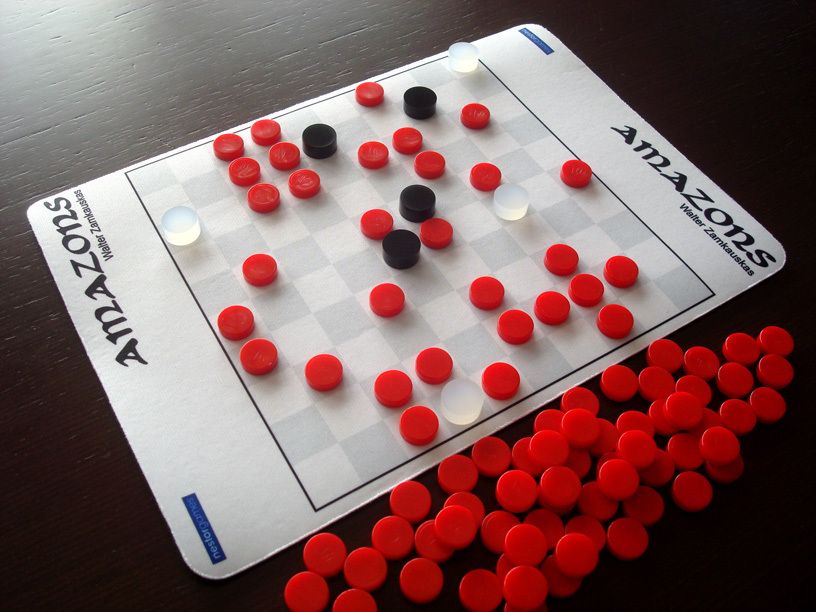Alright, folks, gather round! This is my official review of Amazons, a game my friends and I played until we almost declared war across the dining table. If you like sharp strategy, a fair challenge, and pretty pieces that don’t look like they’ve survived a dog attack, keep reading. I’ll break down the rules, how tricky it is to learn, and spill the beans on strategy, replay power, and just how good it looks on your table—warts and all. Let’s see if this one’s for you, or if you’ll end up flipping the board in a fit of rage (not that I’ve ever…).
How It Plays
Setting up
Grab the game board and plonk it down in the middle. Each player takes four Amazons (the queen pieces) and sets them on their corner spots. Place all arrow tokens nearby. Get ready for a lot of arguing over whose arrows are uglier.
Gameplay
On your turn, move one of your Amazons like a chess queen – as far as you want in any direction but no leaping over obstacles. After you move, you shoot an arrow from that Amazon’s new spot, again like a queen. Place the arrow where it lands. That space is now blocked for the rest of the game. This goes round and round. The board closes up fast. If you can’t move, you’re out, but you still get to watch the chaos (and heckle).
Winning the game
When nobody can move anymore, count the spaces that only you control. Whoever has the most territory wins. If it’s a tie, whoever didn’t spill their drink on the arrows wins. (Or just share the victory, you legends.)
Want to know more? Read our extensive strategy guide for Amazons.
Gameplay Rules and Learning Curve of Amazons
I remember the first time I played Amazons. I sat down, coffee in hand, smug with confidence. “How hard could it be?” I asked. Twenty minutes later, I was calling Google for backup. Don’t worry, it’s not a brain melter, but you’ll want to pay attention for the first round or two.
Amazons comes with a board (10×10 grid), four pieces for each player (your warrior queens), and a sack of black arrow tokens. The game starts simple: move one of your amazons like a chess queen—any number of empty spaces in any direction. After moving, you “shoot” an arrow, which blocks the square it lands on. That’s the entire turn (move and then shoot). The arrows slowly make the board a no-go zone, boxing in your opponent faster than you can say “checkmate.” The game is over when none of your amazons can move; then you count up who has the most free spaces to themselves. That’s the winner!
The beauty (and slight terror) of Amazons is that explaining it takes less time than brewing that coffee, but real skill comes from wrapping your head around the tactics. You’ll stumble a bit your first time, maybe block off your own amazons (guilty), and realize halfway in that you just trapped yourself. It’s got that easy-to-learn, hard-to-master magic that a lot of abstract games go for, but with a twist. No second game ever feels the same.
If you like games where you learn new tricks every time, Amazons is your jam. Next up: let’s see if strategy holds the throne or if luck snuck in wearing a disguise.
Strategy vs. Luck: Who’s Really Calling the Shots in Amazons?
If you like to blame your bad games on bad luck, Amazons might not give you much cover! This game puts the strategy pedal to the metal, and luck only rides in the back seat, reading a map it barely needs. I’ve played with friends who think they’re chess masters and others who just hope not to set their pieces on fire. Amazons made all of us sweat—well, except for that one guy who kept saying “it’s just like tic-tac-toe, but more angry.”
Here’s the thing: every move in Amazons matters. You can’t blame a bad draw or a dice roll for your mistakes. Every time you move an Amazon and fire an arrow, you’re choosing your fate. If you get boxed in, it’s probably your own fault for not seeing the looming trap. The only hint of luck might be in the seating arrangement or who spills the chips mid-game. But the board’s setup is the same each time, so luck won’t hand you a win or stomp you into dust.
Do I wish for a smidge of luck sometimes, just to have something to curse out loud? Sure. But at least it means when you win at Amazons, you really earned it. The satisfaction is real, and so is the sting when you misjudge a move and your friends pounce on your mistake like seagulls on dropped French fries.
Next up, let’s see how Amazons makes you stare deep into your friends’ souls—and check if it keeps you coming back for more rounds without flipping the table!
How Does Amazons Keep Your Friends Coming Back for More?
If you ever want to learn who in your group is good at friendly sabotage, bring out Amazons. This game nails player interaction without making anyone cry (unless you’re super competitive, in which case, have tissues handy). Every turn, my pals and I found ourselves plotting ways to box each other in, block escape routes, and generally mess with everyone’s grand plans. It’s not just about your own queen gliding majestically around the board—it’s about making sure the other queens face roadblocks everywhere they turn.
Amazons does something I’m a big fan of: it lets you develop little rivalries that change with every game. That friend who sneaked past your defenses last match? You’ll keep a close eye on them this time. Everyone’s always wary, yet laughs are guaranteed as new grudge matches pop up round after round. There’s never a dull moment until the very end when the board looks more blocked than a city during rush hour.
When it comes to replay value, Amazons serves up endless variety. Every board state is a puzzle, and the outcome never feels the same. Even if you play against the same group, strategies change. Sometimes I try to go for a fast, sneaky win; other times, I turn into a royal wall-builder. This keeps everyone guessing and hooked for another game—especially since revenge is a dish best served with arrow tiles.
Next up, let’s see if Amazons is easy on the eyes or if you’ll want to play it with the lights out!
Component Quality and Visual Appeal: Does Amazons Shine on the Table?
Let’s talk about the stuff you see and touch—the actual pieces and the way Amazons looks on the table. Because, let’s face it, nobody wants to play a game that feels like it’s made from discount printer paper and sadness.
First up, the board. Amazons comes with a square board that feels solid enough to withstand an accidental elbow from the kid who never learned his arm boundaries. The grid is clear, with lines that don’t fade after a few sessions. I once spilled a questionable beverage on my copy—don’t ask—and it lived to tell the tale. The pieces themselves are chunky and easy to move, which is great unless you have a friend who can’t stop fiddling and makes horse noises while playing. (You know who you are, Dave.)
The queens look regal enough to rule the table, even if their faces are just generic blobs. The arrows are sturdy—though my dog did try to chew one and failed—which I say speaks for their durability. The colors pop nicely, making it easy to spot where you totally messed up your last move. Amazons isn’t flashy, but it puts all the right bits in all the right places.
If you want a game that adds a touch of class to board game night without looking like a prop from a 90s infomercial, I fully recommend Amazons. It’s got the table presence and build quality to match its clever gameplay—and the only thing flimsy at your table will be your excuses for losing.
Conclusion
If you want a game that rewards smart moves over lucky dice rolls, Amazons is a solid bet. It looks great on the table and keeps you thinking with every turn. Gameplay is easy to learn but takes time to master, so you’ll keep coming back for more. Sure, it can get a bit thinky, and if you want chaos or silly fun, this isn’t the one. But if you like a nice, tight duel of wits, Amazons delivers. Thanks for sticking with me through this review – now go block your friends and shoot some arrows!


